Deep in the back roads of Washington State’s Olympic Peninsula, verdant flora resembles something prehistoric, a Jurassic Park of dense ferns packed between towering pine trees and spinous shrubbery. I stare at the tainted moss fungally enveloping a Sitka spruce, pondering The Last of Us and Annihilation and humanity’s brief phase amid eons of natural history. Echoes in the distance interrupt my specious reverie. A plane overhead, maybe, or just the wind playing tricks with on my ears. But then a crisp bark clips through, a rhythm of distinct pops and bangs materialize. The race is coming. I'm here for the Olympus Rally.
Brandon Semenuk in a Subaru Motorsports STI leads the pack on every stage of the American Rally Association’s Olympus Rally, so he starts each stage first and should pass me before the other cars. But until I see that first flash of blue and yellow livery through gaps between the tree trunks, then hear the engine roaring and gravel spraying sideways at top speed, I can’t be certain he’s still in the lead.
Rally racing is a dangerous sport, after all. Tight roads wind between imposing trees, right up to cliff edges, tumultuous traction over technical terrain, rallies can easily seem like all risk and little reward—especially here in America, where rally racing never caught on quite like Nascar, or even IndyCar and now Formula 1.
Worldwide, though, immediately recognizable WRC (World Rally Championship) stars overlap with other icons of motorsport and even children know the histories of Lancia, Audi, Toyota, Mitsubishi, and Subaru. Of late, rally-raid style racing began making a more concerted entry into the American mindset thanks to popularity of Polaris and Can-Am side-by-sides that race there, as well as at the Baja 1000, Mint 400, and King of the Hammers. But stage rally is a whole different business.
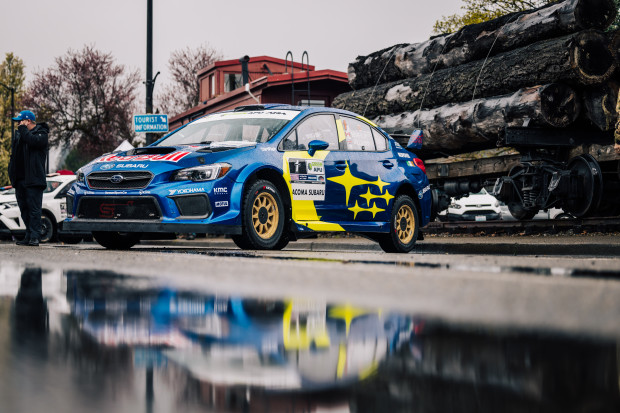
Courtesy Image
Stage Rally Racing Is Different
It all starts with the car. Semenuk’s Subaru might look a lot like a previous-generation STI but is actually a dedicated race chassis prepared by Vermont SportsCar. It has a lightened (read: chopped) and seam–welded body shell, custom front and rear cross members, and plenty of carbon fiber inside and out. VSC also builds the all-electric Class E spec cars for Nitro Rallycross, and is already hard at work on a forthcoming WRX-based model set to debut later this year, since Subaru canceled the STI outright and ARA’s production-based homologation rules still apply.
This year’s regulations center around efforts to more effectively dictate which cars can race in what classes, essentially consolidate the Open 4WD and RC2 classes after drivers like the late great Ken Block imported former WRC cars and entered them right on the skirts of legality. As such, a turbocharged 2.0-liter flat-four pushes power to all four wheels in classic Subie style but limited this year by a smaller 34-millimeter restrictor plate and max boost of 27 PSI.
Subaru now claims the car puts down 330 horsepower and 400 lb-ft of torque, while running at the minimum weight of 2,900 pounds (plus spare tires and drivers). Part of the equation focuses on revised aerodynamic allowances, which Semenuk says make a huge difference despite the fact that rally racing typically reaches far lower average speeds than, say, a day at Daytona.
“With the rule change, there's still lots of little things to try to get the balance perfect,” he told me. “The car feels good overall, but we've been kind of chasing the ultimate setup like we had at the end of last year. So we made some wing adjustments that improved the balance of the car a little bit, for better stability especially when the conditions are kind of slippery and wet.”
Aero plays into the mix, but the suspension travel on these top rally cars is just insane for something that looks a whole lot like a car any consumer can buy—Semenuk tells me his Subaru’s fronts can cover a full 12 inches, which is, without exaggeration, more than the Chevrolet Colorado ZR2 I raced from Vegas to Reno the week before flying up to Washington for the Olympus Rally. Of course, the ZR2 wears 33-inch tires as opposed to the 24.2-inch diameter of the Yokohama Advan A053 tires that Subaru runs.
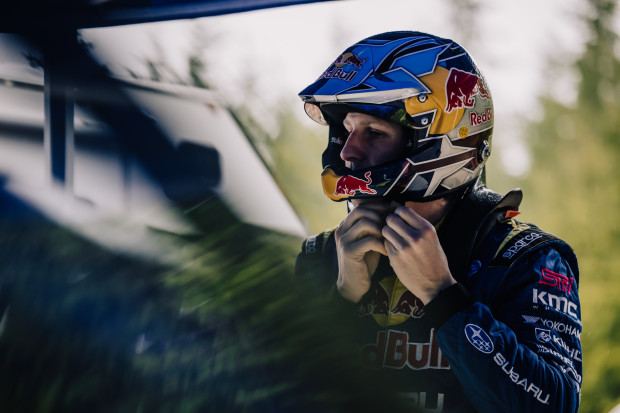
Courtesy Image
Hard-charging Ridealongs With Brandon Semenuk
I learned exactly what the car can do with so much wheel travel on the Thursday before the Olympus Rally, when I joined Semenuk and the Subaru team for a full day of testing on gravel roads near the actual race stages. Over and over, the car went out in different setups, dialing in suspension, downforce, power, and pace.
Loitering about, I mosey over to a pile of the Yokohamas, which range from 180 to 205 millimeters wide so that Semenuk can find the right balance between float and grip in the slop, but I pinch a sidewall out of sheer curiosity. Beefy, to say the least. And Semenuk later tells me the tire sides measure an inch think, so he rarely gets flat unless he makes a huge mistake or puts a wheel in the totally wrong spot.
Then he offers me a chance to hop into the co-driver seat for a few laps. I have no clue what to expect. Will this be like a ridealong at Daytona, all brutal acceleration and lateral G? Or more along the lines of Formula D, some of the best 20 seconds spent sideways in my life?
Turns out, rally racing lands somewhere in between. The Subaru team straps me in tight, helmet and HANS device in the Recaro seat, before Semenuk pulls out. We stop at a cordoned-off intersection of dirt roads, line up all four wheels, and he proceeds to fiddle with the turbo’s anti-lag dial on the steering wheel, then redlines the little engine for about 10 seconds to build boost.
As the Boxer engine’s blattering reaches a crescendo, Semenuk smacks the e-brake off and all four tires scrabble for grip under a full-throttle launch. The old rollercoaster feeling in my stomach crops up before we whip straight into a wide curve, dipping the right front tire in a ditch to hook up and swing around the rears, Semenuk flicking in some countersteering as we pull out onto a squirrelly straightaway, then another pop on the e-brake and we fly sideways into the next tight corner, pushing and pulling out till we whip around and skate through the next bend. My neck strains as I try to keep an eye on what’s coming next, the sound of rocks and gravel slamming the underbody panelling, raucous bangs at up and downshifts, the engine screaming and sputtering, brakes squealing in the grit and grime.
After a little over two miles, we reach a final hairpin and Semenuk lets off the steam. But even pulling in under the service tent, Semenuk swings around with a bit of help from the e-brake. He’s having fun, chatting over the intercom again as we ponder how rally racing almost requires a combination of mountain biking and skiing focus, but on four wheels.
“It is about finding the rhythm,” Semenuk tells me. “But you're always on the edge, as well, so it's easy to kind of fall out of the rhythm on either end. Maybe you over-slow for a corner or you go a little too fast into a corner and then you kind of lose the line, you lose that flow. So it is finding that balance, especially because these roads are so tricky and it's not grip everywhere, you need to be on the line to be able to drive to the maximum.”
Of course, Semenuk’s status as just about the undisputed best mountain biker in the world contributes to that flow and focus, not to mention the physical requirements of such hardcore action. He can stay right in the zone, calm and cool as a cucumber through lap after hard-charging laps. Such skill, but also the confidence of over a decade chasing the rally dream on backroads in the Pacific Northwest—impressive, to say the least.
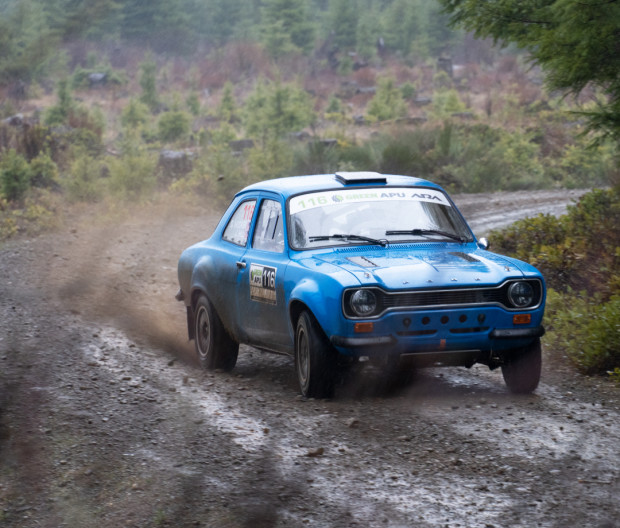
Michael Teo Van Runkle
Learning the Way
Our compatriots at Thursday’s test location brought out an equally awesome car: a 1968 Ford Escort that owner John Hill tells me is “totally Group 4’d out.” While the team of Subaru mechanics work on Semenuk’s settings, Hill and his co-driver Dylan Hooker take hot laps in the old Escort. The little car weighs in nearer to the rear-wheel-drive minimum weight of 2,100 pounds and a 2.0-liter twin-cam Cosworth BDG four-banger pumps out somewhere around 250 horsepower—not bad, but the limitations of traction make sending that power to only the rear tires a delicate matter, resulting in far slower cornering and top-end pace.
Hill even lets me hop into the passenger seat for a few laps in the tail-happy classic. He’s the driver but also personally finances this privateer effort, so he wisely decides not to push anywhere near as hard as Semenuk. To an extent, he’s just dialing in feel before the weekend, which will mark the Escort’s first outing since the build wrapped up. Still, at maybe seven-tenths, the gravel demands the same focus as the little Ford flutters about under power and nose-dives into turns before fishtailing around at that final hairpin. Utter heaven.
Testing wraps at around 3 o’clock in the afternoon as the teams prepare for “recce” the next morning. Short for “reconnaissance” or “reconnoiter” (nobody knows which), the recce day doesn’t allow drivers to explore the stages in advance of the actual race. Instead, Semenuk’s co-driver Keaton Williams takes out a previous-gen Subaru STI wearing skid plates and more Yokohamas, so he can take notes on each stage’s every turn. Semenuk tells me that he and Williams will stays up well past midnight the morning before each race going over notes, which Williams typically calls out with a number first then either a right or lefthand direction. “Six-right” or “three-left,” for example.
The numbers tell Semenuk which gear the Sadev sequential gearbox needs to be in by the time he hits each corner—and therefore, roughly the correct speed, which is more important than the direction that Williams calls out next. Trust in the accuracy of notes and an unconscious rhythm that develops between driver and co-driver make all the difference in the world of rally racing, where the driver’s first time through a stage is at full race-pace.
“If Keaton's on it, if he's delivering the notes right,” Semenuk explains, “that'll keep me on that line and keep us at pace as well. So really that's the biggest part when the rallies are as technical as this.”
Instead of having me follow Williams out for recce, Subaru decides to send me to DirtFish on Friday so I can learn just how much I don’t know about rally racing, car control, and race notes.
Mitch Williams—no relation to Semenuk’s Welsh co-driver—draws the dubiously lucky straw and hops into one of DirtFish’s prepped previous-gen STIs for a day as my coach. With no traction control or ABS, the STI now shows off the full capabilities of Subaru’s legendary AWD system. Williams takes me out first on a skid pad and then through a long slalom, teaching me to maximize straightaways and rethink race lines to minimize sliding at slower speeds.
After each demo, I climb behind the wheel and then typically end up having so much fun drifting that I forget I should be focused on pace. Countersteering far past ideal slip angles, I push the little STI and its hardcore tires to the edge and—only once or maybe twice, I can admit—beyond while whipping around what Williams calls “the W.” And we’re mostly in second gear, so I don’t even have to worry about shifting or braking nearly as much as Semenuk had the previous day (with me calling out absolutely no course notes whatsoever from the passenger seat).
Williams wraps up the day at DirtFish with a quick demonstration of what a more extensive multi-day class might include, pushing the STI through a hard lap around the whole property. Sideways for at least three-quarters of the time, he keeps up a calm conversation pointing out all the locations that David Lynch used to film many of the most iconic scenes in Twin Peaks season 1. Even while nerding out over the saw mill, the sheriff’s office, and the murder bridge, I can’t help but notice how much more smoothly the STI drives with a professional behind the wheel—I reassure myself with the knowledge that he’s been doing this for decades and even plans to enter his own 1976 BMW 2002 at the Olympus Rally the next day, albeit with another driver racing.
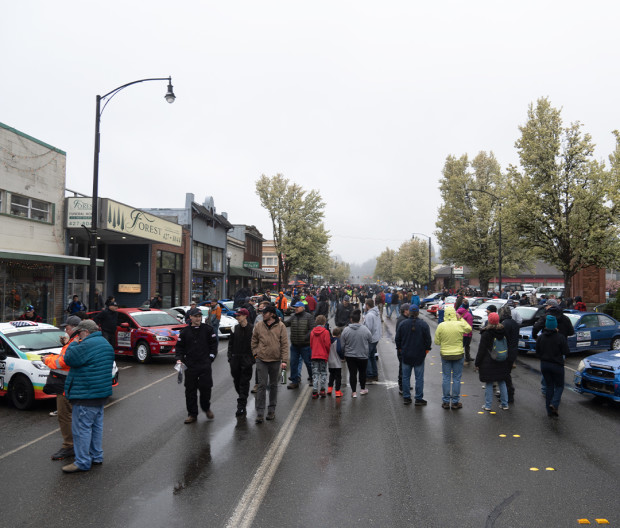
Michael Teo Van Runkle
Parc Expose on the Streets of Shelton
Saturday of the Olympus Rally officially begins with a Parc Expose on the streets of Shelton, a tiny town out on the Olympic Peninsula. Despite a light drizzle that will continue for much of the next 36 hours, respectable crowds stroll through checking out the rally cars before the racing begins. A little press conference stage interviews some of the more well-known personalities, including Semenuk, but for the most part, the morning seems more like a grassroots cars-and-coffee scene.
Only the roll cages, small wheels wearing big tires, and full fire suits belie the relaxed atmosphere, really. No endless lines of GT3 RS Porsches or chrome rims here. I wander around in rally heaven, classic Subarus and Mitsubishis left and right, but also everything and anything under the (lack of) sun, from E36 BMWs to Lexus IS350s, Ford Focuses, even a Toyota Starlet and a Ferrari V8-swapped STI. But I don’t spot Hill’s Escort—oh boy, what now?
After an hour in Shelton, the circus picks up and heads out to the official start line of Stage 1, where we wait for the racers to arrive. Each car entered in ARA must remain street legal, so the teams can transit between stages and a central service location, in this case on a long strip of nearby Sanderson airport.
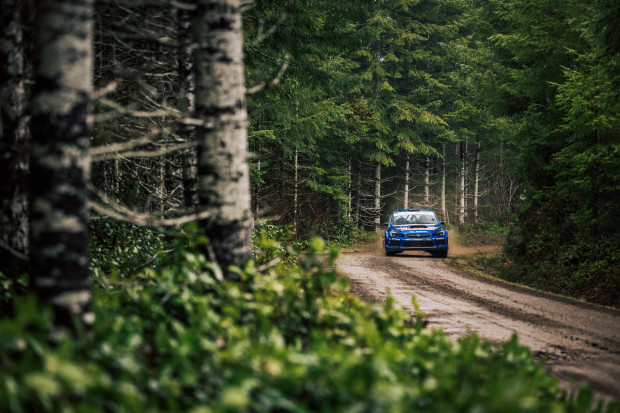
Courtesy Image
Hiking Through Jurassic Woods
Much like Semenuk showed me during testing, the race starts with each car redlining before a hard launch. And in fact, Semenuk kicks off Stage 1 at the head of the line, before the rest of the cars follow at timed intervals. Modulation of traction and power proves important even from the get-go, as some cars (especially RWD) struggle to find grip and others pull away with ease under a bit less throttle. In a hilarious moment, the Ferrari-swapped Subaru winds up that V8 in a glorious symphony, only to shed a rear tire within the first second off the line—guess they focused more on keeping the Italian engine running than sweating the little details, like lug nut torque specs.
The crowd cheers each car and team for the first few turns of a little short course viewing era, then they’re off into the woods. I spend the next couple of hours sprinting between viewing positions along the stages, typically alongside little clumps of hikers willing to find the best spots along the route but occasionally behind closed gates available only for the media access. Even on Stage 1, the field splits early as a car catches fire and another nearly hits a bear. Then we rush off to the service airstrip, to learn that Semenuk has already established a solid lead and aims to keep it.
Related: Dream Garage: The Car and Truck Auctions We'd Bid on Right Now
But I’m watching other cars too, the foreign WRC hatches, a few Mitsubishi Lancer Evos, the first and second-gen Imprezas. There’s even an AMC AMX fully kitted out with rally legend Tim O’Neil driving and a Geo Metro with a bright pink paintjob over green wheels pulling up the caboose at a snail’s pace.
At service, many of the other teams deal with breakdowns, mud piled into wheel wells, checking ball joints and torquing down every last nut and bolt—lessons learned to avoid embarrassment of that Suba-rrari, to say the least. The hubbub attracts spectators happy to loiter around in the rain, but I wrap up the day deep in the woods once more for Semenuk’s flying finish for the day’s final stage, brakes and sparks and light pods ablaze.
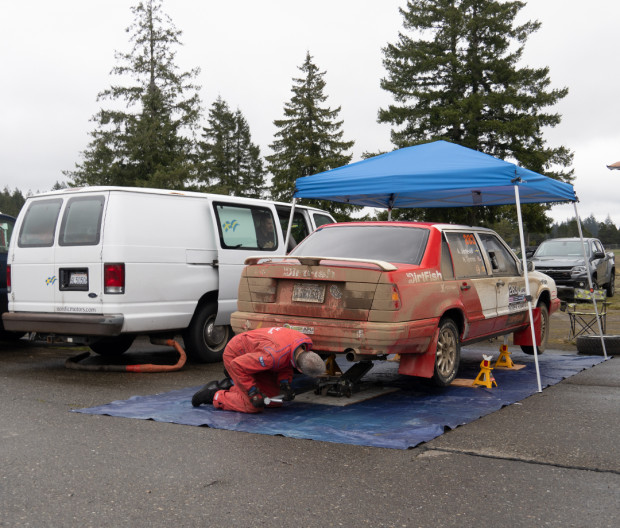
Michael Teo Van Runkle
Grassroots Motorsport on Full Display
Have you ever wanted to race? Or go drifting? How about a radical combination of the two on remote backroads all over the U.S.?
I spend a sleepless Saturday night mulling over what, exactly, it would take to get in on the fun. An affordable car, to start, with cheap and easy parts availability. Strip the interior, install a roll cage, beef up the suspension—just enough to build up towards actual racing in ARA, making connections in the rally world while honing the skills required to get anywhere near Semenuk’s pace.
A roughed-up Lancer Evo sounds fun or, like so many privateer teams, maybe a caged and gutted beater Subaru. Then again, in the era of social media, something more eye-catching might help with sponsorships to cover at least basics, like tires and oil—an Audi TT or a 996-generation 911 Carrera 4 with all-wheel drive. The thought of a brand-new Subaru sounds alright, too, given the modern performance and the fact that at least the latest generation still comes with a manual, but an STI sounds that much better until I start thinking about the inevitable damage that goes hand-in-hand with amateurs rally racing.
No racing is cheap, I know, but maybe this series is the way to go. The old racer’s adage comes to mind more than once: “How much do you want to spend?” “How fast do you want to go?” But the allure of sliding through woods at any speed...I’m hooked, to say the least, and I tell Semenuk as much the next morning. He laughs, fully aware how his own addiction ramped up on the dirt roads of British Columbia while hunting for perfect mountain biking trails.
Related: Subaru Wants to Help the National Parks Eliminate Landfill Waste
“We've got the Subaru, which has been one of the fastest factory cars in America and, obviously, they come from world rally,” Semenuk tells me. “So the engineering and knowledge is insane. And then at the other end of the field, you're gonna have production cars and real-world driver’s cars and classic cars. That's what I love about it, you know, there's almost a hundred cars and there's basically the people that come here with their garage builds and are just here to have some fun. Then there's the people building up their experience, aspiring to be the next top driver.”
That next top driver could be me, I figure, or any of the fans waiting for that last part to pull together their own backyard build. Much of the ARA organization scraps together similarly, as many of the officials volunteer with no wages to support each race. The cost of entry even varies depending on whether race teams want to qualify regionally or enter the national series—I heard ranges from $300 to $1,500, but in a fun little promo, Subaru Motorsports helps by covering the first few privateer Subies that enter each rally.
Don’t think ARA isn’t serious about safety, though: I found out later that Hill’s Escort failed to pass scrutineering due to what sounded like a clerical error of pages missing in the car’s roll cage documentation. Talk about a bummer.
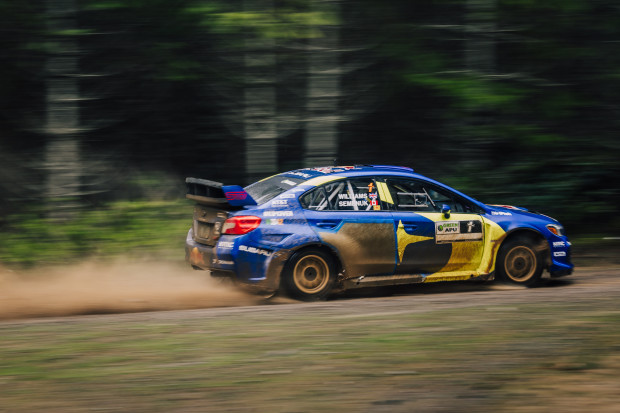
Courtesy Image
Victory All but Certain but Certainly Not Easy
Sunday starts early again, no Parc Expose for me but instead straight out onto first stage and another day racing around the woods catching little snippets of race. Luckily, Subaru loaned me a brand-new WRX to blast around in, so with a bit more experience under my belt I catch more of the action. On the second and final day of racing, the field passes through each spectator and media location more clumped up, drivers in contention trying to make up time on Semenuk’s lead and those at the rear just trying to survive. Plenty of cars dropped out overnight.
The crowds swell on Sunday, too, and get rewarded with an afternoon of hard rain. Two Super Stages for the national competitors wrap up the Olympus Rally, allowing better spectator viewing near the start line of Stage 1 on that short course again. The puddles grow and grow as the afternoon turns to dusk—even a grizzled vet like Tim O’Neil crashes his AMC and the Ford Fiesta in second place driven by Tom Williams (again, no relation) flips on the final stage while trying to eke a few more points out of the last day.
Semenuk only builds on that early lead of 24 seconds after Stage 1, adding 10 or more seconds through nearly every stage despite knowing to push slightly below ten-tenths to minimize risk. He and the Subaru team only really struggle with one true malfunction, a handbrake pin that rattles out of place and renders the e-brake useless for the final few miles of a stage. Easy fix, luckily. On the podium Sunday night, Semenuk and Williams celebrate a win in the open 4WD class. Budding star Lia Block, meanwhile, wins the 2WD class in a prepped BRZ.
With both Ken Block and fellow Subaru star Travis Pastrana not racing, victory at Olympus and a championship for Semenuk can easily seem like a foregone conclusion. But keep in mind that he still needs to go out and get sideways at top speed on gnarly gravel roads for eight weekends in 2023. And as I learned during testing, throughout a day at DirtFish, and dancing around the prehistoric woods of the Olympic Peninsula, absolutely anything can happen while rally racing.
from Men's Journal https://ift.tt/j04XK59


0 comments